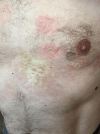Borrelia burgdorferi and autoimmune mechanisms: implications for mimicry, misdiagnosis, and mismanagement in Lyme disease and autoimmune disorders
- PMID: 38578312
- PMCID: PMC11424747
- DOI: 10.1007/s00296-024-05580-x
Borrelia burgdorferi and autoimmune mechanisms: implications for mimicry, misdiagnosis, and mismanagement in Lyme disease and autoimmune disorders
Abstract
The genus Borrelia encompasses a diverse group of spirochetes transmitted primarily by ticks, with Borrelia burgdorferi causing Lyme disease, which is prevalent in North America and Europe. Borrelia's structural adaptations and ability to persist in diverse host tissues underscore its pathogenic potential. Beyond traditional infectious responses, Borrelia engages in complex interactions with the host immune system, contributing to autoimmune mechanisms such as molecular mimicry and persistent infections. This intricate interplay manifests in symptoms resembling various autoimmune diseases, including systemic lupus erythematosus, dermatomyositis, local scleroderma, and systemic sclerosis. However, these associations lack a precise explanation, emphasizing the need for further investigation. The cases of misdiagnosis between Lyme borreliosis and autoimmune diseases highlight the critical importance of accurate diagnostics and adherence to guidelines. Understanding Borrelia's impact on immune responses is pivotal for advancing diagnostics and targeted therapeutic interventions in Lyme borreliosis and its potential autoimmune implications.
Keywords: Borrelia; Dermatomyositis; Molecular mimicry; Scleroderma; Systemic lupus erythematosus.
© 2024. The Author(s).
Conflict of interest statement
Both authors declare no conflict of interest.
Figures


Similar articles
-
[Lyme borreliosis].Internist (Berl). 2003 Feb;44(2):175-6, 179-82. doi: 10.1007/s00108-002-0770-y. Internist (Berl). 2003. PMID: 12674737 Review. German. No abstract available.
-
Molecular mimicry to Borrelia burgdorferi: pathway to autoimmunity?Autoimmunity. 2004 Aug;37(5):387-92. doi: 10.1080/08916930410001713098. Autoimmunity. 2004. PMID: 15621562 Review.
-
Molecular survival strategies of the Lyme disease spirochete Borrelia burgdorferi.Lancet Infect Dis. 2004 Sep;4(9):575-83. doi: 10.1016/S1473-3099(04)01132-6. Lancet Infect Dis. 2004. PMID: 15336225 Review.
-
[Analysis of Borrelia burgdorferi genostrains among patients with Lyme disease].Przegl Lek. 2009;66(9):511-2. Przegl Lek. 2009. PMID: 21033412 Polish.
-
Lyme arthritis: linking infection, inflammation and autoimmunity.Nat Rev Rheumatol. 2021 Aug;17(8):449-461. doi: 10.1038/s41584-021-00648-5. Epub 2021 Jul 5. Nat Rev Rheumatol. 2021. PMID: 34226730 Free PMC article. Review.
Cited by
-
Central nervous system manifestations in rheumatic diseases.Rheumatol Int. 2024 Oct;44(10):1803-1812. doi: 10.1007/s00296-024-05679-1. Epub 2024 Aug 13. Rheumatol Int. 2024. PMID: 39136787 Review.
-
Lyme-Borreliosis Disease: IgM Epitope Mapping and Evaluation of a Serological Assay Based on Immunodominant Bi-Specific Peptides.Biomedicines. 2025 Aug 8;13(8):1930. doi: 10.3390/biomedicines13081930. Biomedicines. 2025. PMID: 40868184 Free PMC article.
References
Publication types
MeSH terms
LinkOut - more resources
Full Text Sources
Medical

